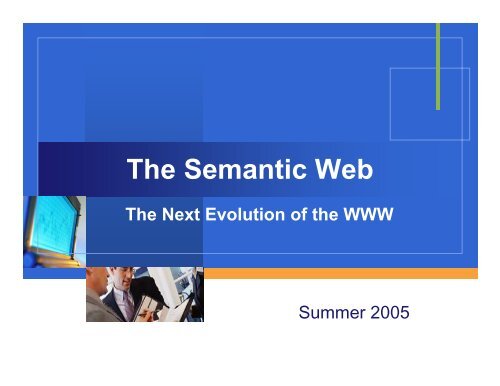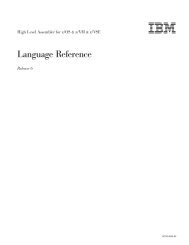The Semantic Web
The Semantic Web
The Semantic Web
Create successful ePaper yourself
Turn your PDF publications into a flip-book with our unique Google optimized e-Paper software.
<strong>The</strong> <strong>Semantic</strong> <strong>Web</strong><br />
<strong>The</strong> Next Evolution of the WWW<br />
Company<br />
LOGO<br />
Summer 2005
Overview<br />
• What is the <strong>Semantic</strong> <strong>Web</strong><br />
• Background<br />
• Components of the <strong>Semantic</strong> <strong>Web</strong><br />
• Why the <strong>Semantic</strong> <strong>Web</strong> is needed<br />
• Uses of the <strong>Semantic</strong> <strong>Web</strong><br />
• Implementing the <strong>Semantic</strong> <strong>Web</strong><br />
• Examples<br />
• Conclusion
What is the <strong>Semantic</strong> <strong>Web</strong><br />
<strong>The</strong> <strong>Semantic</strong> <strong>Web</strong> is "an extended web of<br />
machine-readable information and automated<br />
services that amplify the <strong>Web</strong> far beyond<br />
current capabilities" (Daconta et al.)<br />
• A framework that:<br />
Adds meaning to data<br />
Provides a mechanism for organizing,<br />
interpreting, and making use of that meaning
What is the <strong>Semantic</strong> <strong>Web</strong> (cont)<br />
• An enhancement to the current <strong>Web</strong>, not a<br />
replacement<br />
“<strong>The</strong> <strong>Semantic</strong> <strong>Web</strong> will bring structure to the<br />
meaningful content of <strong>Web</strong> pages, creating an<br />
environment where software agents roaming<br />
from page to page can readily carry out<br />
sophisticated tasks for users” (Berners-Lee et<br />
al.)
Background<br />
• 1968 – Internet used as a communications<br />
network by DOD<br />
• 1989 – Tim Berners-Lee (and others) at<br />
CERN develop HTML from SGML<br />
• Early 1990s – <strong>Web</strong> browsers created to<br />
interpret HTML<br />
• 1996 – XML developed<br />
• 1990s+ – Tim Berners-Lee & W3C<br />
continue to pursue development the<br />
<strong>Semantic</strong> <strong>Web</strong>
Components of the <strong>Semantic</strong> <strong>Web</strong><br />
• Four major components:<br />
XML<br />
Resource Description Framework (RDF)<br />
Ontologies<br />
Agents
Supplemental Components of the<br />
<strong>Semantic</strong> <strong>Web</strong><br />
• Supplemental components<br />
Uniform Resource Identifiers (URIs)<br />
<strong>Web</strong> services<br />
Inference rules<br />
Service discovery<br />
<strong>Semantic</strong> aware applications<br />
Security and trust<br />
XML and RDF schemas
XML<br />
• HTML (XHTML) is a series of predefined<br />
tags that add presentation to data<br />
This text is bold<br />
• XML is a series of user-defined tags that<br />
add information to data<br />
John Smith
XML (cont)<br />
• Issue:<br />
<br />
"XML has become the universal syntax for<br />
exchanging data between organizations"<br />
(Daconta et al.)<br />
Some mechanism must exist for coordinating the<br />
meaning of the user-defined tags and for<br />
understanding the context of that information<br />
Company A: Smith<br />
Company B: Jones<br />
Company C: Williams
Resource Description Framework<br />
(RDF)<br />
• An XML-based language used to describe<br />
resources<br />
• Resources can include entities, concepts,<br />
properties and relations<br />
• Captures the meta data about the<br />
“externals” of a document<br />
• Can use a serialized model, RDF triplets,<br />
special notation, or graphs to describe<br />
data
Resource Description Framework<br />
(RDF) (cont)<br />
• Example serialized model<br />
• RDF triplet (subject, predicate, object/literal):<br />
Predicate<br />
Object<br />
sells<br />
Software<br />
Subject<br />
Company<br />
Predicate<br />
Literal<br />
Is named<br />
Microsoft<br />
<strong>The</strong> company sells software<br />
<strong>The</strong> company is named Microsoft<br />
John Smith is the president of Company X<br />
Next
<br />
Ontologies<br />
“the common words and concepts (the<br />
meaning) used to describe and represent an<br />
area of knowledge" (Daconta et al.)<br />
• Provide the repositories for meaning<br />
interpretations<br />
• Provide a mechanism for defining the<br />
relationship among different words and for<br />
the <strong>Semantic</strong> <strong>Web</strong>, relationships among<br />
different resources
Ontologies (cont)<br />
• Consist of:<br />
Taxonomies<br />
• “An organized set of terms.” (McComb, 204)<br />
• A classification and a tree (Daconta et al., 2003)<br />
• Hierarchal, tree-like structures similar to<br />
organizational charts<br />
• Example<br />
Sets of inference rules<br />
• Should be used to organize semantics, but<br />
not knowledge<br />
Next
Taxonomy Example<br />
Return
Agents<br />
• Also known as software agents<br />
• Provide automation services<br />
• Should not be designed to replace<br />
humans or to make decisions<br />
• Examples: <strong>Web</strong> spiders and crawlers
Supplemental Components of<br />
the <strong>Semantic</strong> <strong>Web</strong><br />
• Uniform Resource Identifiers (URIs)<br />
Provide a mechanism for identifying available<br />
resources<br />
• <strong>Web</strong> services<br />
Allow computer applications to communicate<br />
directly with each other over the Internet<br />
• Inference rules<br />
Define the relationships and rules between<br />
data
Supplemental Components of<br />
the <strong>Semantic</strong> <strong>Web</strong> (cont)<br />
• Service discovery<br />
<br />
Allows applications to find ontologies and agents<br />
• <strong>Semantic</strong> aware applications<br />
<br />
Applications that can make use of semantic<br />
information<br />
• Security and trust<br />
• XML schema<br />
<br />
<br />
Define the structure of XML documents<br />
Standardizes the communication between systems<br />
• RDF schema or OWL<br />
<br />
Can be used to define the language used in ontologies<br />
and RDFs
Why the <strong>Semantic</strong> <strong>Web</strong> is Needed<br />
• <strong>The</strong> current <strong>Web</strong> remains largely<br />
unstructured (e.g., company)<br />
• Large amounts of information remain<br />
unavailable
Uses of the <strong>Semantic</strong> <strong>Web</strong><br />
• Improve e-business processes<br />
• Improve business-to-business (B2B)<br />
communication<br />
• “assist human users in their day-to-day online<br />
activities” (Antoniou & van Harmelen, 2004)<br />
• “build knowledge and understanding from raw data”<br />
(Daconta et al., 2003)<br />
<br />
<br />
<br />
<br />
<br />
Improve knowledge management<br />
Improve information retrieval<br />
Automate tasking<br />
Integrate data<br />
Maximize customer value and profits
Implementing the <strong>Semantic</strong> <strong>Web</strong><br />
• Convert data to XML format according to defined<br />
XML schemas<br />
• Expose applications as <strong>Web</strong> services<br />
• Build ontologies that specify semantic<br />
meanings and the relationships between<br />
data<br />
• Create agents that make use of the semantic<br />
data, automate search processes, and<br />
automate other business processes
Issues Concerned with<br />
Implementing the <strong>Semantic</strong> <strong>Web</strong><br />
• Cost<br />
• Security<br />
• Nonstandard technology issues<br />
• <strong>Semantic</strong> precision
Examples<br />
• http://www.foaf-project.org/<br />
• http://www.cs.umd.edu/users/hendler/<br />
• http://www.cs.umd.edu/projects/plus/SHO<br />
E/cs.html<br />
• http://www.daml.ri.cmu.edu/Cal/<br />
• http://www.semanticwebsearch.com/refere<br />
nce.rsp
Conclusion<br />
• What is the <strong>Semantic</strong> <strong>Web</strong><br />
• Background<br />
• Components of the <strong>Semantic</strong> <strong>Web</strong><br />
• Why the <strong>Semantic</strong> <strong>Web</strong> is needed<br />
• Uses of the <strong>Semantic</strong> <strong>Web</strong><br />
• Implementing the <strong>Semantic</strong> <strong>Web</strong><br />
• Issues concerned with implementing the<br />
<strong>Semantic</strong> <strong>Web</strong><br />
• Examples<br />
Questions
References<br />
• Antoniou, G., & van Harmelen, F. (2004). A semantic <strong>Web</strong> primer.<br />
Cambridge, MA: <strong>The</strong> MIT press.<br />
• Athauda, R. I. (2000). Integration and querying of heterogeneous,<br />
autonomous, distributed database systems (Vol. 61/06, pp. 3126):<br />
Florida International University.<br />
• Berners-Lee, T., Hendler, J., & Lassila, O. (2001). <strong>The</strong> <strong>Semantic</strong> <strong>Web</strong>.<br />
Scientific American, 284(5), 34-43.<br />
• Carey, P., & Kemper, M. (2003). New perspectives on creating <strong>Web</strong><br />
pages with HTML and Dynamic HTML (2nd ed.). Boston: Course<br />
Technology.<br />
• Daconta, M. C., Obrst, L. J., & Smith, K. T. (2003). <strong>The</strong> <strong>Semantic</strong> <strong>Web</strong>:<br />
A guide to the future of XML, <strong>Web</strong> services, and knowledge<br />
management. Indianapolis, IN: Wiley Publishing, Inc.<br />
• Ewalt, D. M. (2002, October 14). <strong>Semantic</strong> <strong>Web</strong>. InformationWeek, 35-<br />
44.<br />
• Galitz, W. O. (2002). <strong>The</strong> essential guide to user interface design. New<br />
York: John Wiley & Sons, Inc.
References<br />
• Gould, M. (1996). Rules in the virtual society. International Review of<br />
Law, Computers & Technology, 10(2), 199-218.<br />
• Kalakota, R., & Robinson, M. (2001). e-Business 2.0: Roadmap for<br />
success. Upper Saddle River, NJ: Addison-Wesley.<br />
• Lexico Publishing Group, L. (2004). Inference. Retrieved December 7,<br />
2004, from http://dictionary.reference.com/searchq=inference<br />
• McComb, D. (2004). <strong>Semantic</strong>s in business systems: <strong>The</strong> savvy<br />
manager's guide. San Francisco, CA: Morgan Kaufmann Publishers.<br />
• Tiwana, A. (2002). <strong>The</strong> knowledge management toolkit. Upper Saddle<br />
River, NJ: Prentice Hall PTR.<br />
• Warren, P. (2003). <strong>The</strong> next steps for the WWW: Putting meaning into<br />
the <strong>Web</strong>. Computing & Control Engineering, 14(2), 27-31.<br />
• Young, M. J. (2002). XML step by step (2nd ed.). Redmond, WA:<br />
Microsoft Press.













